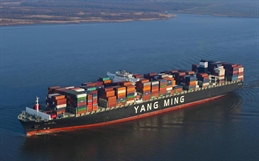
CO2 emissions from the container industry fell during the first quarter of 2023 across 10 of the world's busiest 13 ocean freight lanes, according to the latest industry analysis from Xeneta.
Based on the Carbon Emissions Index (CEI) — a unique environmental benchmarking tool from Xeneta and Marine Benchmark — the trade corridor making the biggest emissions inroads was the US West Coast to the Far East lane.
Meanwhile, the report noted that Yang Ming emerged as the industry's 'emissions hero' for the second consecutive quarter.
The scores, Emily Stausbøll, Xeneta Shipping Analyst, said, showed quarterly improvements on many trades for the start of 2023.
However, Stausbøll cautioned over whether this trend is "here to stay", noting that it's perhaps not just environmental commitment that is lowering the CEI scores.
"Global shippers looking to shrink the carbon footprints of their logistics chains will be delighted to see some meaningful falls in emissions on key freight corridors," the Xeneta analyst said, noting that in the aftermath of MEPC 80 and the IMO's accelerated GHG commitments, such improvements should certainly be applauded.
"But the question is, what happens when the market improves? Will we see commercial considerations trump environmental ones? Time will tell how committed individual carriers are here," Stausbøll added.
The Xeneta analyst went on to note that much of the improvements are down to carriers reducing speeds, which delivers fuel efficiency gains while also allowing them to cater for considerably lower demand in a subdued macroeconomic climate.
She added that the US West Coast to the Far East lane (a backhaul) saw a speed reduction of almost 1 knot, which, when combined with an increase in vessel sizes and a stable filling factor, enabled an 11.3% CEI improvement from Q4 2022.
"We're also seeing several alliances add capacity to services, for example, when newbuilds are coming online, and then slow down the speeds of deployed ships. This allows them to add the vessels without increasing capacity in real terms (due to the slower transit times)," Stausbøll said.
"This strategy, it's fair to say, is driven by business rather than environmental considerations," she cautioned.
Xeneta's data shows that only three trades increased speeds across the quarter and that all were fronthaul routes, namely; from the Far East to North Europe and to the US East Coast, and from North Europe to the US East Coast.
It added that of the 13 leading corridors, the only ones to show an increase in quarterly CEI scores, and therefore emissions, were North Europe to the Far East and to the US East Coast, and from the Mediterranean to the US East Coast.
Despite the favourable current trend, the Xeneta report noted that there's a mixed long-term perspective, with four trades actually recording worse CEI scores in Q1 2023 than in Q1 2018.
It said that the Mediterranean to US East Coast trade is "bottom of the barrel" with a 13.6% higher CEI. At the other end of the scale, the "star performer" is the Far East to the US East Coast corridor, with a 21.2% improvement for the same period.
"In general, we are seeing some positive steps forward," Stausbøll said, "with many carriers getting just the right balance of vessel speed, size and filling factor."
She noted that, in particular, there's good news for the many exporters out of the Far East, with the top five trades from the region all showing significant improvements over Q1 2018.
"None of these trades had a CEI above 91 - in other words, an improvement of at least 9% since the index was introduced," the Xeneta analyst added.
Yang Ming records best CEI
The Xeneta report noted that the best individual carrier is Yang Ming, which also recorded the best CEIs in Q4 2022.
The Taiwanese giant was the cleanest carrier — when measured by CO2 emitted per ton of cargo carried — on three trades, with OOCL and HMM securing the top spot on two trades a piece.
"Yang Ming was the only major carrier to score below the trade lane average on all the trades where it deployed ships. It also sailed younger ships than the trade lane averages and, importantly, sailed slower," Stausbøll said.
"With the environment so high on the agenda — for customers and financers, as well as regulators — the commercial argument for this kind of commitment is almost as strong as the environmental one," she added.
"If more carriers can follow Yang Ming's lead, then it's a strategy that could really pay dividends in more ways than one."
The CEI is built on a foundation of real-time AIS data and individual vessel specifications, allowing it to track and calculate environmental performance per ton of cargo carried across the sector's busiest trade routes.
It uses a baseline score of 100 to assess carriers in relation to the trade lane average at the start of 2018.
The CEI covers 13 main trade corridors: Far East – Mediterranean, Far East - North Europe, Far East - S. America E. Coast, Far East - US East Coast, Far East - US West Coast, Mediterranean - Far East, Mediterranean - US East Coast, North Europe - Far East, North Europe - S. America E. Coast, North Europe - US East Coast, US East Coast – Mediterranean, US East Coast - North Europe, and US West Coast - Far East.



